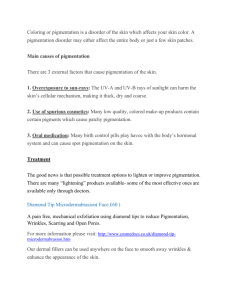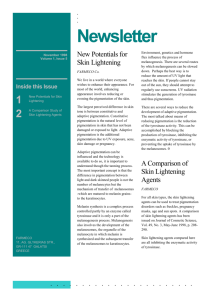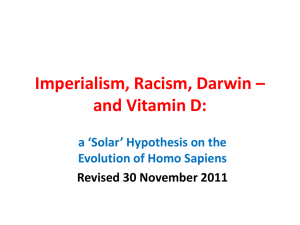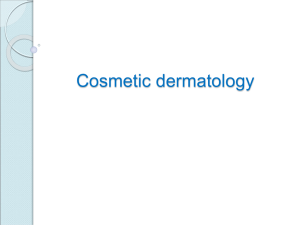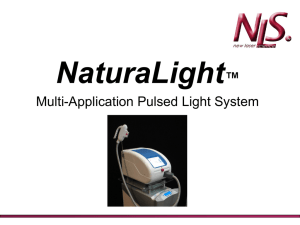Oral Pigmentation-2
advertisement
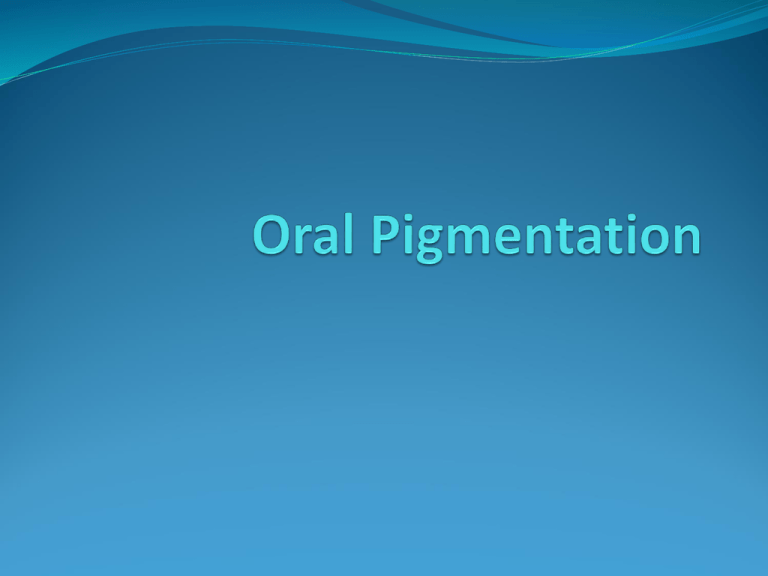
Melanocytes are pigment-producing cells that are derived from neural crest cells Melanin is formed from tyrosine by the action of tyrosinase Oral melanin pigmentation ranges from brown to black to blue according to the amount of melanin production and the depth of the pigment. Etiology Congenital or acquired Benign or malignant Endogenous or exogenous Causes of Oral Pigmentation Congenital Racial (Melanoplakia) Naevi Peutz-Jegher’s syndrome Acquired Endocrinopathies Metabolic (Hemochromatosis) Neoplastic Metals Food/drugs (oral contraceptives, antimalarials , minocycline tranquilizers) AIDS Benign causes of oral pigmentation Physiologic pigmentation Ephelides Lentigo Oral melanotic macule Smoking melanosis Intraoral nevi Malignant causes of oral pigmentation Melanoma Neuroectodermal tumor of infancy Endogenous causes Postinflammatoty hyperpigmentation Melanoacanthoma Addison’s syndrome Peutz- Jegher’s syndrome Laugier-Hunziker syndrome Exogenous Drugs Amalgam tattoos Cultural or medical tattooing Jailhouse tattoo Heavy metals Racial pigmentation Results from increased amount of melanin pigmentation Usually in Blacks and Asians, but also Mediterranean littoral May be present in white descendents Usually involves the gingivae (attached), but can affect other oral sites Variable colour and extent Asymptomatic Racial pigmentation Differential diagnosis: Addison’s disease Albright’s Syndrome Heavy metal pigmentation Use of antimalarial drugs Ephelides Ephelides are sun-induced freckles that are most commonly seen in very fairskinned individuals, especially those with red or auburn hair. They occur most frequently in childhood, and tend to reduce in number with age. Lentigo Solar lentigos, in contrast to ephelides are more common in older individuals and persist indefinitely. They are common on the face and may be seen in the perioral region. They range in size from 2 mm to 2 cm and are usually tan to dark brown in colour. Variation in colour or irregularity of outline should raise the suspicion of lentigo maligna and is an indication for histological evaluation. Naevi They are seen in mostly young people between the ages of 20 and 39 years. Sixty per cent are intradermal naevi and approximately 25% are blue naevi. Naevi Usually elevated Palate is commonly affected site Less than 1cm diameter Not premalignant Naevus of Ota an acquired oculodermal melanocytosis involving the skin of the face, the eyes and mucous membranes. It is most common in Japan, appearing usually in female patients in early adult life. Melanoacanthoma Rare Usually a feature of blacks Aetiology unclear but probably secondary to physical trauma Areas of melanotic hyperpigmentation, typically beneath a denture They present as slightly elevated circumscribed solitary asymptomatic pigmented plaques. Melanoacanthomas have been reported to occur on buccal, palatal and gingival mucosa. Requires to be differentiated from Addison’s disease No premalignant potential Endocrinopathies causing oral pigmentation Addison’s disease Nelson’s syndrome Ectopic ACTH production Pregnancy Addisonian pigmentation May arise with any cause of adrenocortical hypofunction (autoimmune, infection, tumour) Typically involves the buccal mucosa May be the only clinical features of adrenocortical hypofunction The pigmentation is secondary to increased ACTH production by the anterior pituitary Addisonian pigmentation Pigmentation is not specific to Addison’s however if associated with candidal infection, endocrine studies should be performed Brown or black color is seen in more than 75% of Addison’s patients Nelson’s syndrome Rare Excess ACTH production and pituitary expansion secondary to bilateral adrenalectomy for Cushing’s disease. 10% develop oral pigmentation Oral pigmentation like Addison’s disease Ectopic ACTH production Rare Excess ACTH production by bronchial adenocarcinoma Oral hypermelanotic pigmentation similar to Addison’s disease, but possible additional involvement of the soft palatal mucosa Chloasma Feature of late pregnancy Manifests as melanotic hyperpigmentation of the midface Involvement of the oral mucosa is extremely rare Albright’s (McCune-Albright) syndrome Rare Polyostotic fibrous dysplasia, sexual precosity, cutaneous hyperpigmentation, occasional other endocrinopathies Possible melanotic hyperpigmentation of the oral mucosa (in addition to unilateral or bilateral fibrous dysplasia) Haemochromatosis Autosomal recessive Mechanism of iron overload not clear Iron deposition in hepatocytes More commom in males (female menstruation will lessen the iron load) Usually does not present clinically until the 5th decade Haemochromatosis Investigations: Elevated serum iron, reduced TIBC, elevated ferritin Iron in hepatocytes of biopsy Thalassemia Patients may have a dusky-brown complexion - reflects iron accumulation post-transfusion Rarely there may be melanotic pigmentation of the oral mucosa and gingivae Melanoacanthoma Pigmentary incontinence Uncommon Usually arises in late age in association with oral lichen planus Patients are often tobacco smokers Areas of melanotic pigmentation in site of present or past lichen planus Asymptomatic Exclude Addison’s disease Smoker’s Melanosis Drug-induced oral mucosal pigmentation olours can be blue, brown, black, grey, green C Drug-induced oral mucosal pigmentation Blue Amiodarone Antimalarials Bismuth (overdose) Mepacrine Minocycline Quinidine Silver Sulphasalazine Drug-induced oral mucosal pigmentation Brown Betal nut Busulphan Clofazimine Oral contraceptives Cyclophosphamide Doxorubicin Doxycycline Fluorouracil HRT Heroin HRT Ketoconazole Menthol Minocycline Pholphthalein Propanolol Zidovudine Drug-induced oral mucosal pigmentation Black Amiodaquine Betal nut Methyldopa Drug-induced oral mucosal pigmentation Green Copper Grey Amiodiaquine Chloroquine Fluoxetine Hydroxycholoquine Lead Silver Tin/zinc Local causes of oral pigmentation Ecchymoses Ephelis Melanoma and other malignancies Melanoacanthoma Naevus Melanotic macule Tattoos (amalgam, ink, graphite etc) Local causes of oral pigmentation melanotic macules Brown or black Usually affect lips or gingivae Arise at any age Not premalignant Oral Melanotic Macule - tattoos Caused by intentional or accidental implantation of exogenous pigments into the mucosa Amalgam tattoo or focal argyrosis is the most common and appears as blue-black, non-elevated discoloration that is usually irregular in shape and variable in size. Deterioration of the silver compounds of the amalgam impart the characteristic color of the lesion Can affect any where but the favorable site is the gingiva. The clinical diagnosis can be confirmed by radiography otherwise failure of radiographic evidence necessitates biopsy to rule out more serious lesions tattoos Other tattoos include graphite pencil wounds and India ink tattoos Can reflect ritual (eg gingivae, lips) May reflect lifestyle Harmless Amalgam Tattoo Local causes of oral pigmentation bacillary angiomatosis Rare Usually a feature of HIV disease Caused by Bartonella quintana or Bartonella henselae Gives rise to pigmented nodules Can affect the skin, bone and liver Responds to erythromycin Local causes of oral pigmentation malignant melanoma Oral disease is rare Male:female ratio=2:1 Mostly in persons>50 years of age Often affects the palate, mainly maxillary alveolar ridge, anterior gingiva and labial mucosa, but can involve other oral sites Oral lesions may be primary or secondary tumours Localised brown or black macule, papule, or nodule, often with ulceration and destruction. Rarely lesions may spread superficially malignant melanoma Early recognizable signs: asymmetric lesion, border irregularity, color variation, and diameter enlarging Late signs: bleeding and ulceration, firmness on palpation and rock-hard regional lymph nodes Early diagnosis when tumors are less than 1.5 mm in diameter and complete resection are critical to long term survival. Poor outcome likely Malignant Melanoma Ephelis (Freckle) Light to dark-brown macule on the lip due to exposure to light Remains unchanged in size but may darken Has predilection to light-skinned or redheaded persons Investigation of oral pigmentation History of present complaint Medical history - hypoadrenocorticism, pulmonary disease, drug history etc Social history - tobacco or betel nut habit? ethnicity? Extra-oral examination - evidence of cutaneous disease etc Intra-oral examination - localised or generalised ? Blood pressure Serum electrolytes 24 hour urinary cortisol Synacthen test Biopsy Discoloration of teeth Extrinisic Intrinsic Smoking Tetracycline Beverages Fluorosis Drugs(iron, Amelogenesis imperfecta chlorehexidine, minocycline) Poor oral hygiene Betel chewing Kernicterus Porphyria
